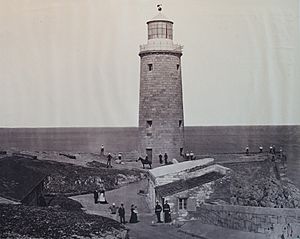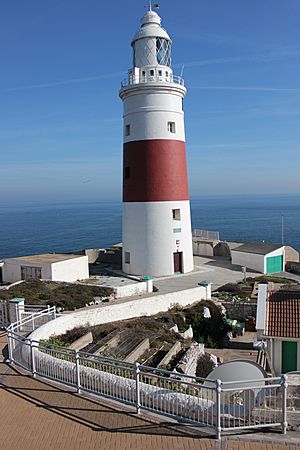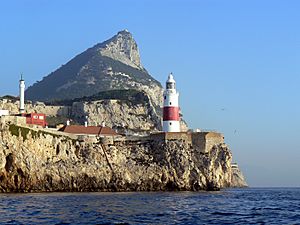Europa Point Lighthouse facts for kids
| Tower shape | cylindrical tower with balcony and lantern |
|---|---|
| Original lens | Single-tier LED |
The Europa Point Lighthouse is a famous lighthouse located at Europa Point. This is the very southeastern tip of Gibraltar, a British territory at the southern end of the Iberian Peninsula. It stands right at the entrance to the Mediterranean Sea. People also call it the Trinity Lighthouse at Europa Point, the Victoria Tower, or La Farola in Llanito, which is the local language of Gibraltar.
This important lighthouse first opened on August 1, 1841. About 10,000 people came to see the special opening ceremony. Over the years, the lighthouse has been updated many times to make its light brighter and more powerful. For example, in 1864, its simple lamp was replaced with a stronger one. It was fully automated in 1994, meaning it could run by itself. In 2016, it was updated again to use modern LED lights.
The Europa Point Lighthouse is managed by an organization called Trinity House. The lighthouse tower is shaped like a cylinder and is painted white with a wide red band in the middle. It stands about 20 meters (66 feet) tall. Its light shines from 49 meters (161 feet) above the high-water mark, helping ships find their way safely.
Contents
History of Europa Point Lighthouse
The Europa Point Lighthouse, also known as the Trinity Lighthouse or Victoria Tower, began being built in 1838. It has a classic British design. Sir Alexander George Woodford, who was the Governor of Gibraltar at the time, laid the first stone for the lighthouse on April 26, 1838. This was a special event, and a message was carved into the stone.
The message said the lighthouse was built to help ships in the Mediterranean Sea. It was also meant to save lives and honor the British name. About 10,000 people watched this important ceremony. The lighthouse was finished in 1841 and opened on August 1 of that year. More than 2,000 people came to see the light shine for the very first time.
Before the lighthouse was built, sailors relied on a light from the Shrine of Our Lady of Europe. This was a Catholic shrine that used to be a mosque. Sailors would leave oil at the chapel to keep its lights burning.
When the lighthouse first opened in 1841, it had a simple oil lamp with one wick. A large lens system helped make the light stronger. In 1843, the lighting was improved so it could be seen better from Sandy Bay. By 1854, the lighthouse's light could be seen from about 16 miles (26 kilometers) away.
Upgrades and Modernization
Between 1863 and 1864, the lighthouse was repaired and improved by an engineer named Henry Norris. The single-wick lamp was replaced with a stronger four-wick burner. A new, much better lens system was also added. These improvements included a special red light that warned ships about a dangerous area called Pearl Rock. This red light was made strong enough to reach Pearl Rock, which was 6 miles (9.7 kilometers) away.
In 1875, the lamp was changed again to a four-wick mineral oil burner. More changes happened in 1894 to make the light even brighter. The four-wick burner was replaced with an eight-wick burner, and the lantern was improved. This made the light 35,000 times brighter than a single candle. The way the light flashed also changed. It became an "occulting" light, meaning it would shine for a long time and then briefly go dark. An explosive fog signal was also added, making two quick blasts every five minutes.
In 1905, the eight-wick burner was replaced with a three-mantle burner. Then, in 1923, a new petroleum vapor burner was installed.
Electric Lighting and Automation
Between 1954 and 1956, big changes were made to the lighthouse. Electric lighting was added, which made the light much more visible. A powerful, spinning lens system was also put in place. This new system made the light appear white for 5 seconds, then off for 5 seconds, from most directions. However, when seen from the dangerous Pearl Rock area, it appeared as a red light.
At this time, a separate red light was also added below the main light. This light shone a steady red beam across the same dangerous area. To fit all this new equipment, the tower was made 6 feet (1.8 meters) taller. Loud foghorns were also installed next to the tower. They would sound one blast every 20 seconds.
The lighthouse became fully automated in February 1994. This meant it could operate without people needing to be there all the time. The old lenses were kept, but new lamp changers were added. The foghorn was also changed to an electric model.
In 2016, the lighthouse got another big upgrade to its lighting and electrical systems. The old spinning lens was removed. It was replaced with two modern LED lanterns that shine a white light all around. One LED lantern is the main light, and the other is a backup. At the same time, the fog signal was stopped. The old lens from the 1950s was given to the new University of Gibraltar, where it is now on display.
About the Lighthouse
The Europa Point Lighthouse is still active today. It is located at the very southeastern tip of the Rock of Gibraltar at Europa Point. This is a very important spot between the Atlantic and Mediterranean seas. The light shines from 49 meters (161 feet) above the sea. The Mediterranean Sea is to the east, the Bay of Gibraltar is to the northwest, and the Strait of Gibraltar is to the southwest.
The lighthouse tower is 19 meters (62 feet) tall and is made of stone. It has a lantern room and a walkway around the top. The tower is painted white with a wide red band in the middle. Locals in Gibraltar call it "La Farola", which means 'lamppost' in Spanish.
How the Lighthouse is Managed
The Europa Point Lighthouse is special because it is the only lighthouse outside of the British Isles that is operated by Trinity House. Trinity House is a lighthouse agency based in England. This is why it is also called the Trinity Lighthouse. Trinity House was given the job of building and running the Europa Point Lighthouse by a law passed in 1838. Later, another law in 1894 confirmed that Trinity House was in charge of lighthouses for Gibraltar.
The land where the lighthouse stands is managed by the Government of Gibraltar. The lighthouse is monitored by a station that is connected by telephone to the Gibraltar Port Office.
After World War II, amateur radio (also called ham radio) became popular in Gibraltar. The Gibraltar Amateur Radio Society has its headquarters on Coaling Island. Once a year, during the third weekend of August, they operate from the lighthouse. This event is part of the International Lighthouse and Lightship Weekend. Their goal is to put the Europa Point Lighthouse "on the air" using the special call sign ZB2LGT.
See also
 In Spanish: Faro de Punta Europa para niños
In Spanish: Faro de Punta Europa para niños




